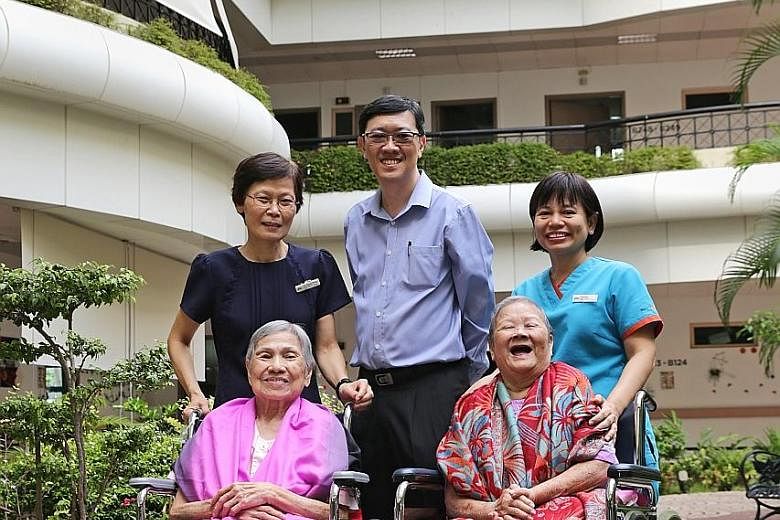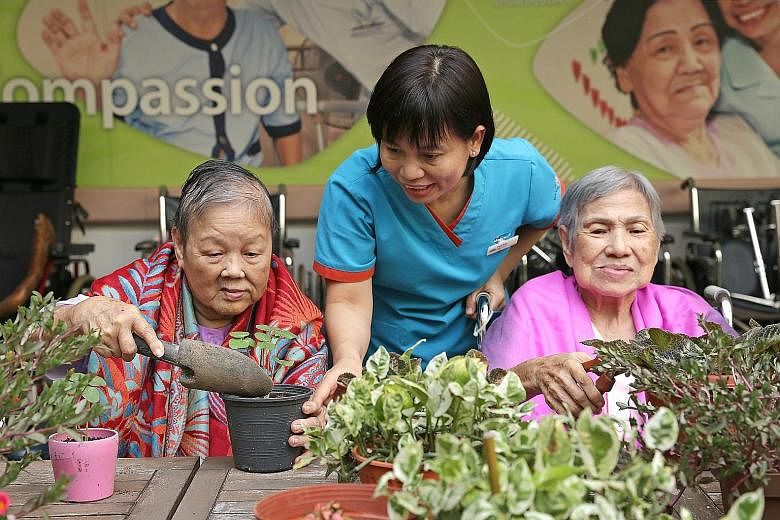When she came to Singapore in 2001 to work as a nursing aide at All Saints Home, Ms Naw Paw Ray, who is from Myanmar, intended to stay for just five years.
More than 15 years later, Ms Paw Ray, now a senior staff nurse at the nursing home's Tampines centre, has found her life's calling in caring for the elderly.
The 42-year-old is a familiar face to the home's nearly 200 residents, some of whom she has formed close bonds with over the years.
"I like the environment here. Sometimes the job is tiring, but when we see the residents happy, we are also happy," she said.
Such is her dedication to her charges that she took up Hokkien and Malay classes, paid for by the home, to better understand their needs.
It is care staff like her that nursing homes need to attract and retain to address its current manpower challenges, said All Saints Home chief executive officer Michael Tay.
The home, which celebrated its 30th anniversary in November, started with 30 beds in a converted hall of Bethel Presbyterian Church in Hougang under the auspices of Reverend Lee Huai Kwang.
It has since grown to become the largest nursing home in Singapore run by a voluntary welfare organisation, with four centres and 734 beds.
With an ageing population and rising cases of dementia, nursing homes here have had their resources stretched thin, said Mr Tay, 57.
The Ministry of Health plans to increase nursing home beds by 5,000 to 17,000 by 2020 .
More pressing, however, is the need to grow the workforce of care staff in a sector that can be daunting to nursing trainees, said Mr Tay.
"It's easy to build the structure and put in the beds, but the real issue is trying to find the right people willing to take up the challenge of caring for the residents," he said.
Apart from the comparatively lower pay in nursing homes, "in a hospital or clinic, the patient comes and goes, you move on. Here you see the same residents day in and out with the same problems", he added.
Higher pay, while a boon, would not address the mindset and lack of recognition that deters healthcare workers from joining the nursing home sector, he said.
"The impression that people have of nursing homes is that it is depressing.
"MOH, together with industry service providers, will need to reshape this impression. I would say that while it is more challenging in a nursing home, it is precisely for this reason that this job is even more of a calling than being a nurse in a hospital," he said.
A study commissioned by the Lien Foundation, which urged a new model of care, cast a spotlight on nursing homes last year. It found that it would cost as little as $8 more a day for a resident to stay in a single or double-bedded room instead of the six- to eight-bed layout common in nursing homes, including All Saints Home.
In response, Mr Tay said the model was "nice to have", but impractical given the significant additional costs and space constraints.
"To me, care staff are the heart of nursing homes... If the service standards are not there, it makes no difference whether he or she is staying in a single-bedder or an eight-bedder.
"Besides funding the infrastructure, we should also be focusing on funding the training of care service staff," he said.
One way that All Saints Home plans to focus its manpower resources for the coming year is to better utilise its base of volunteers.
With the number of patients with dementia rising, the home hopes to use volunteers to engage residents in activities that improve their psychosocial well-being to help delay or slow its onset.
Last year, it started a collaboration with St Luke's ElderCare, which runs elderly daycare centres. Seniors from St Luke's Whampoa ElderCare centre make regular trips to All Saints Home's Hougang centre to spend time with its residents.
"They get on very well because they're the same age and can relate to one another.
"This is something we hope to explore with other service providers as well," said Mr Tay.
Madam Tan Lai Ho, 86, a resident of All Saints Home's Tampines centre, said she enjoys chatting with friends and tending to the garden. She said: "The nurses are very good to us, I am very happy here."



